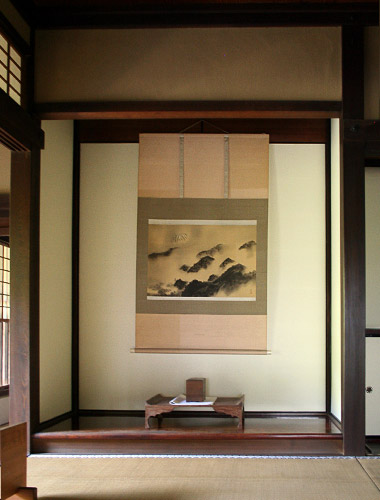|
||
 |
||

Nagatomi
永富 house (Hyougo)
(C)2001 Japanese Architecture and Art Net Users System. No reproduction or republication without written permission.
掲載のテキスト・写真・イラストなど、全てのコンテンツの無断複製・転載を禁じます。
|
||||||
| itadoko 板床 | ||||||
| KEY WORD : architecture / tea houses | ||||||
| An alcove with a wooden floor instead of a *tatami
畳 mat. There are two methods of making an itadoko. The first is to construct
a framing board like those in an ordinary alcove *tokonoma
床の間, and set the board floor even with the top of the frame which raises the alcove
floor above the tatami mat floor of the tea ceremony room *chashitsu 茶室. Red pine, zelkova
or Japanese horse chestnut are commonly used for the flooring. The frame can be
finished with black lacquer, plain wood with the grain visible, or a bark-covered
piece of wood cut from a log showing the marks of an adze *chouna
釿. Example: Saigyouan Kainyoan 西行庵皆如庵, in Kyoto. The other method is called kekomidoko
蹴込床 and does not elevate the boarded floor of the alcove above the level of the
tatami mat floor of the tea ceremony room. Example: Fujimitei 富士見亭 at Gotou
五島 Museun, in Kyoto. |
||||||
 Nagatomi
永富 house (Hyougo)
|
||||||
| REFERENCES: | ||||||
| EXTERNAL LINKS: | ||||||
| NOTES: | ||||||
(C)2001 Japanese Architecture and Art Net Users System. No reproduction or republication without written permission. 掲載のテキスト・写真・イラストなど、全てのコンテンツの無断複製・転載を禁じます。 |
||||||